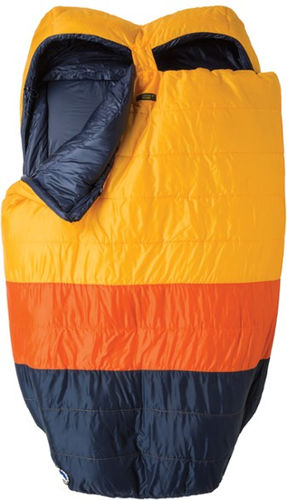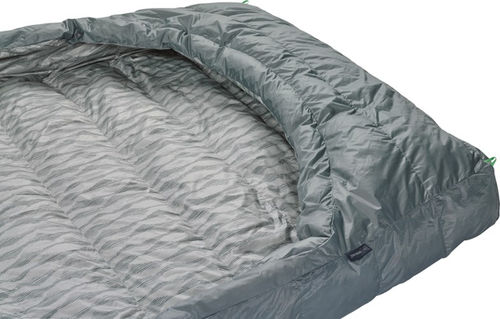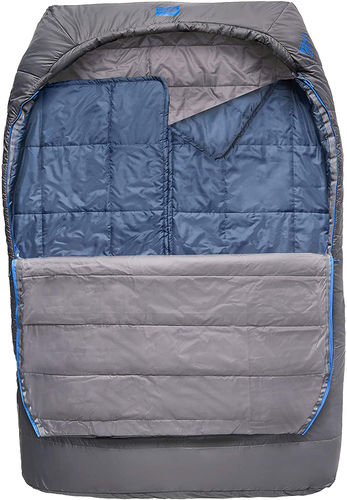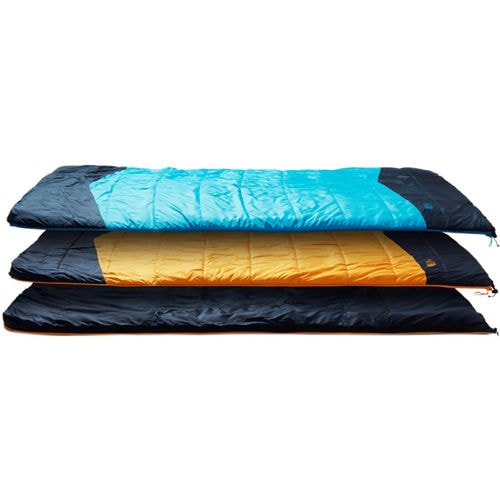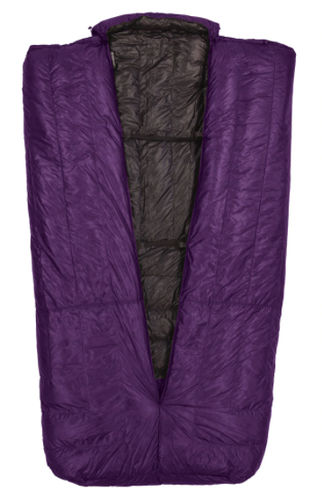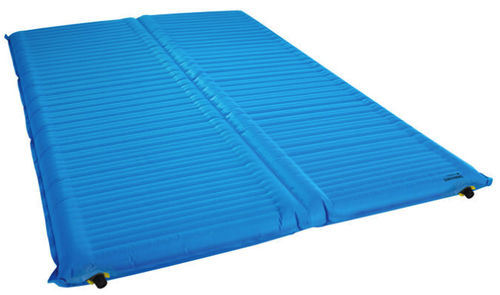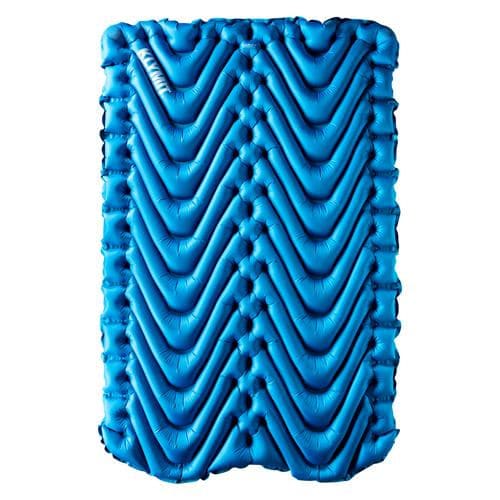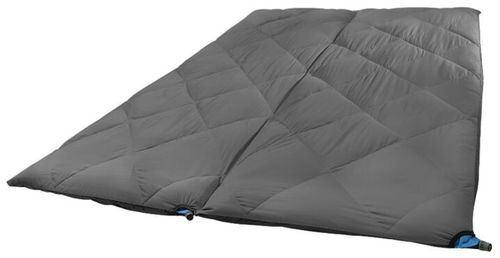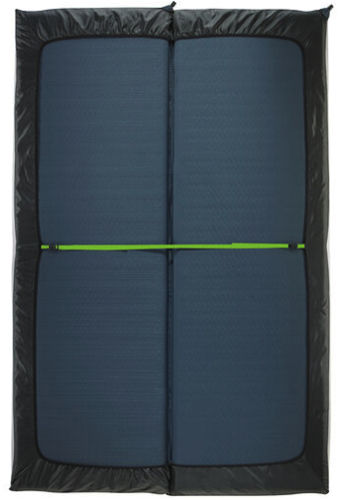 When you buy something using links in our stories, we may earn a small commission. Read more about our policy.
When you buy something using links in our stories, we may earn a small commission. Read more about our policy.
When I started camping and backpacking with my then-boyfriend, I was typically freezing at night while he snored blissfully next to me. I started (silently) resenting him and (loudly) threatening get to a two-person sleeping bag. He didn’t think it was necessary, but I wanted his warmth even if his feet were significantly more dirty.
When backpacking, double sleeping bags just make sense considering the weight when compared to two single sleeping bags.
Double sleeping bags are also great for letting your kids climb in to sleep with you and four-legged friends who like to cuddle up at night.
While there are single sleeping bags that you can zip together, they are going to be more drafty than a proper two-in-one. Zipping two together is still a great setup if you plan to use them separately often, but if you’re ready to invest in a double sleeping bag, you’ll see a big difference in comfort and warmth.
A big part of what makes double sleeping bags more comfortable and warm than adjoining two singles is the double sleeping pad. Scroll down for more on that and the best models to consider.
The best two-person sleeping bags
Therm-a-Rest Vela Quilt Double 32 Sleeping Bag
It has both sleeping bag and quilt in its name (see below for the differences between the two), this one fits squarely in the quilt category, with no hood or zippers, which makes it significantly lighter than most other models at just 2 lbs 3 oz. Filled with responsibly-sourced 650-fill-power Nikwax Hydrophobic Down, the insulation absorbs 90% less water than regular down and dries 3x faster.
Kelty Tru.Comfort Doublewide 20 Degree Sleeping Bag
This sleeping bag has a 5-star rating on Amazon with almost 300 reviews. That says it all. Kelty makes quality outdoor gear, and this bag currently sells for under $200. It offers individual ventilation, a fully removable zip-off top layer, two built-in blankets, foot vents, and an oversizes hood large enough for two standard pillows. It’s our top choice for car camping, wider than a queen bed and less than 10 lbs.
The North Face Dolomite One Double Sleeping Bag: 15F Synthetic
A three-in-one system, this sleeping bag comes with two top layers than can be used separately or together to get the temperature rating you need. One of the layers is lined with fleece, which means extra coziness because you know there’s nothing colder than a sleeping bag’s typical nylon lining.
Enlightened Equipment Accomplice Sleeping Quilt
Another quilt, the Accomplice is another lightweight option, perfect for backpackers. It comes with straps to attach snugly to a sleeping pad, and four color options coincide with different temperature ratings. If you need a different size, temperature rating, filling, or color, they also offer custom quilts.
Nemo Equipment Jazz Synthetic Double Sleeping Bag
If this photo hasn’t already sold you, this bag includes a removable sheet, built-in pillow top, draft collar, integrated pad sleeve to keep your sleeping pad in place, and while mostly rectangular, does have a tapered geometry to keep your feet cozy and warm.
Marmot Zuma Double Wide 35 Sleeping Bag
Another affordable option, this double sleeping bag unzips completely to create a blanket for even more warmth options. It also has internal grab handles to help you get situated all nice and cozy inside, with a hood to help trap body heat in low temperatures.
Double sleeping pads
While you might be tempted to bring your blow-up mattress—which I’ve done plenty a time—or a fancy bedding kit like this one from REI, one thing to know is that these cushier mattresses don’t insulate as well as sleeping pads. Sleeping pads are built with insulation in mind with specific materials and designs that help trap the warm air from your body, thus keeping the cold ground temperatures out.
For the most comfortable night’s sleep, a double sleeping pad is the way to go. One larger pad will stay in place better than joining two single pads together, and they keep the cold out better since there’s no middle point of separation—even if it’s small, you’ll feel cold air seep in. And if you’re cuddling, having a seamless middle will be another noticeable difference. Some pads also have raised sides to keep you from falling off and added even more insulation to the sides, which is a nice touch.
Exped MegaMat Duo 10 Sleeping Pad
This is a mini-mattress at 3.9″ thick and nearly 10 lbs, but much more insulated with the highest R-value of all the sleeping pads sold at REI. It’s self-inflating and comes with. a mini pump to help customize the cushioning to your liking. IT also deflates quickly with a large valve making the dreaded pack-up process even easier and faster.
Therm-a-Rest NeoAir Camper Duo Sleeping Pad
Unlike the above, this sleeping pad is two separate chambers, which is great if someone likes to sleep super soft and the other more firm. It also helps prevent your sleepmate from feeling your every toss and turn. Therm-a-Rest dominates the sleeping pad/bag category with durable, functional products.
Sleeping pad couplers
If you don’t want to invest in a double pad, pad couplers let you join two singles togethers. To create an optimal double sleep system, you’re going to want rectangular sleeping pads. Mummy bags typically use mummy-shaped sleeping pads, but this will obviously leave an awkward gap between your legs and let even more cold air in while you both struggle not to fall off.
There are straps that can attach two single sleeping pads together to form one, but this isn’t going to keep the pads in place as well.
Sleeping bags vs sleeping quilts
While sleeping bags are the standard go-to for sleeping outside, quilts are quickly on the rise. What’s the difference between the two?
- Quilts do not wrap around your entire body. Unlike sleeping bags, they don’t have a backing of any kind, which is usually very thin but doesn’t offer any insulation, so it’s just extra weight. This is the main difference between the two and the reason most backpackers opt for quilts.
- Many quilts do have buckles or clips that you can use to strap to a sleeping pad underneath to keep it in place.
- Quilts typically don’t have hoods like most sleeping bags, but they do have the same foot box that sleeping bags have.
- Most quilts do not have zippers.
- Sleeping bags will typically keep you warmer with the cinched hood or draft collar. However, looking more closely at the differences, the same temperature-rated sleeping bags and quilts could differ in the amount of down, so a quilt with more down could theoretically keep you warmer than the same rated sleeping bag.
What to consider when looking at sleeping bags
When shopping for a sleeping bag or quilt—single or double—there are a few things to take into consideration:
- Weight: If you’re car camping, weight matters less, but for backpackers, this is one of the primary concern.
- Style: Sleeping bags come in a few different cuts, or shapes. Mummy sleeping bags are the most restrictive—at both the upper body and around your legs—helping to trap in heat with less space for cold air to hang out. They also tend to be the lightest, using the least amount of fabric. Semi-rectangle sleeping bags are mummy-style up top but open up into a rectangle at your legs and feet, so you have a bit more wiggle room. Rectangle sleeping bags are the roomiest and usually have zippers all the way around, both aspects making them the least insulated, depending on the specific rating, of course.
- Material: With all outdoor gear, it comes down to natural or synthetic materials. Down is typically warmer, lighter weight, and compresses much smaller than anything made with synthetic materials. They’re cozy af and breathe better, helping to regulate your body temperature. However, they don’t do well in water or damp conditions. At all. Moisture collapses the filling/insulation and immediately rids its warming powers. Synthetic materials, on the other hand, will continue to insulate when they get a bit wet, and they typically cost less than down. They won’t compress nearly as small, so a great option for car camping, but not backpacking.
- Temperature rating: To avoid wearing every layer you packed, make sure the sleeping bag is rated to the temperature outside. Read more about temperature ratings, known as R-values.
- Packability: for backpacking, that matters greatly, but even if you’re car camping, you don’t want your sleep system to take up half the trunk. You still have a tent, cooler, food, chairs, hammocks, etc.
- Tent size: Since most two-person tents don’t spare much room for bags or anything more than two sleeping bags, opt for a three- or four-person tent even if it’s just for a couple. You’ll have much more interior space and can comfortably fit your bags at your feet.
- Price: The lighter the gear, the more it costs. The better the material, the more expensive. You can certainly get good gear for less, but this is the general rule of thumb.

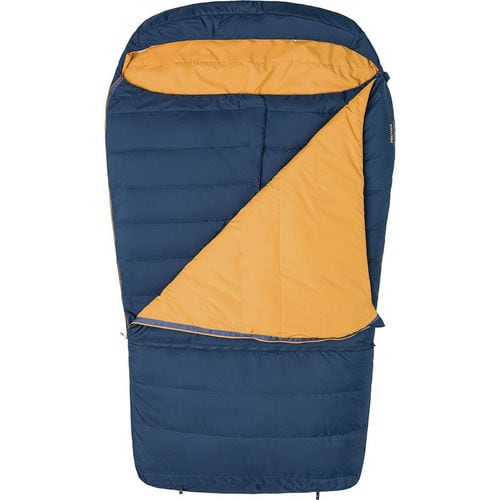 When you buy something using links in our stories, we may earn a small commission.
When you buy something using links in our stories, we may earn a small commission. 